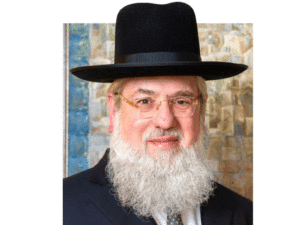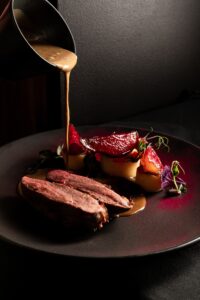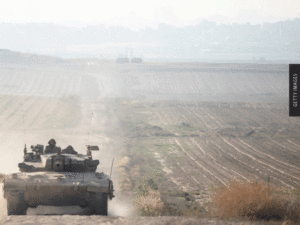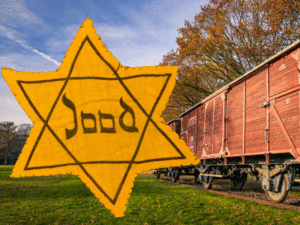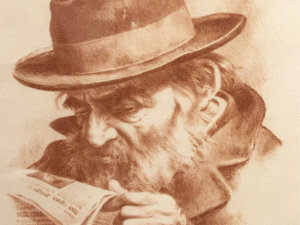CLOSE TO HIS RABBEIM AND GEDOLIM
In Mesivta Torah Vodaas, he drank thirstily from the fountains of his rabbeim, including Rav Reuven Grozovsky, Rav Gedalya Schorr, and Rav Elya Chazan. His hasmodah in those years was well known, both in the Mesivta, as well as when he joined Bais Medrash Elyon for 10 years. At one point, he learned with the same chavrusa the whole day to maximize his learning.
In addition, he became close to many great rebbes and tzaddikim. He would join the hakafos of the Satmar Rav on Simchas Torah, and would tell how he was at the port when the rebbe’s ship arrived in America.
He carried this over to his children, too. He would take us to the Satmar Rav on Hoshanah Rabbah; to hear the maamarim of Rav Hutner on Chol Hamoed; and to the drashos of the Matesdorfer Rav on Shabbos Shuva and Shabbos Hagadol. He had a kesher to many tzaddikim, including Rav Moshe Feinstein and the rebbes of Skulen, Ribnitz, and Bobov, and he would take us to bask in their greatness.
Our father would also go to the Klausenberger Rebbe and talked about his great ahavas haTorah. He would quote the speech the rebbe gave at the chanukas habayis for his new beis medrash. The rebbe announced that if anyone had a chiddush while learning in the beis medrash and didn’t have paper to write it down, they would be welcome to write their chiddushei Torah on the beautiful white walls.
HARBOTZAS HATORAH
After three years in the kollel of Bais Medrash Elyon, Rav Gedalya Schorr asked him to give a shiur in the mesivta, and he started his decades-long career of harbotzas haTorah, which would last almost his entire lifetime. As one rebbi pointed out, he didn’t just teach his students; his ahavas haTorah was so tangible and contagious that it flowed over until his talmidim also felt that love for Torah.
He once told the Kapshinitzer Rebbe that he was a melamed, a teacher of Torah. The rebbe told him that he was following in the ways of Hashem, who is “melamed Torah l’amo Yisroel.” This is a suitable description of his harbotzas haTorah—teaching others, in the way Hashem does to the Jewish nation.
LIKE A FIRE
Chazal say, “If a rebbi is like a malach, you should go learn from him.” This can be explained with the Kedushas Levi in Parshas Mishpatim. The posuk says “u’marei kvod Hashem k’eish ocheles – the appearance of the glory of Hashem is like a burning fire.” The Kedushas Levi writes that this is the litmus test one should use to know if the glory of Hashem is there. If the rebbi connects to the fire of Torah, like a malach, then we know the shechinah is there and it is someone to learn from.
This is something our father’s talmidim all pointed to. When their rebbi would learn, he would be on fire. In fact, he would perspire so much that, even in the winter, he would ask talmidim to open the window. He would encourage talmidim to join him in the rischa d’oraisa and enjoy the learning with him. He would show them how every point in the Gemara can be questioned and understood better after toiling to grasp properly.
AHAVAS HATORAH
When he learned, it was clear that the Torah was not just an extra, but life itself. A talmid related that their rebbi was a model of true mesikus haTorah, as the Ohr Hachaim Hakadosh famously writes, “If people would appreciate the greatness of the Torah and truly feel its sweetness, they would chase after it, and no money in the world would have meaning.”
This ahavas haTorah was also seen by his family. When his son started to learn Gemara, his excitement was palpable and he made a kiddush to celebrate this great milestone. Such actions left an indelible impression about what is a true cause for celebration.
AMEILUS BATORAH
His concept of ameilus baTorah was not just as a means to understand, but something important in itself. The posuk says, “im b’chukosai teileichu – if you will follow my laws,” which Rashi says is referring to toiling in Torah. The Sfas Emes points out that learning Torah is referred to as a chok, the parts of the Torah we don’t understand. This teaches us that it is the ameilus itself which is essential, even if one does not understand what he has learned.
A talmid said that in his shiur, he would show how each line of the Gemara can be analyzed and understood in different ways. Similarly, another talmid said it was clear that his calling in the shiur wasn’t necessarily to show the final pshat, but to show the greatness of Torah, and open their minds to gain a deeper appreciation for the different ways of understanding the sugya.
One who reaches this level of Torah will merit the next part of the posuk. The Torah continues: “v’nosati gishmeichem b’itam – I will give you rain at the right time.” This means that one who is immersed in Torah will have his needs taken care of. As a talmid reflected, his rebbi was truly content with his lot. After seeing his rebbi’s true joy from learning Torah and then seeing the simplicity of his home, he chose to follow his rebbi’s lofty ways and chose a career of chinuch.
TEACHING IN DIFFERENT VENUES
For many years, we davened with Rav Moshe Bick, until the talmidim of Torah Vodaas, who lived in the neighborhood, asked him to become the mara d’asra of their shul. He led them for a decade, giving shiurim in halacha and agaddah, until the demographics changed and people moved out.
At that time, he was asked to give a daf yomi shiur in Alexander for older Yidden, many of whom were Holocaust survivors. He learned with them for over 20 years, finishing Shas three times. Each siyum would be celebrated with great fanfare, and the attendees would talk about how much they loved him and enjoyed his shiurim. This seder gave him the opportunity to teach many masechtos which are not usually covered in the standard yeshiva curriculum.
At one point, he was giving three different shiurim each day: the early morning daf, his regular daily iyun shiur, and he also gave an afternoon bekius shiur several times a week. He used to go around with a tape recorder, to facilitate preparing the different shiurim wherever he went.
CHESED
Meshulachim who needed a place to stay always felt welcome in our house, often coming for long periods of time. He would encourage them and help them in any way that he could. We saw a live example of the words of Rav Itzele Volozhiner, in the hakdomah to Nefesh Hachaim, quoting his father, Rav Chaim Volozhiner, “A person is not in this world for himself, but for others, and one must do whatever he can to help others.”
SHOSHELES MOSREI HATORAH
The Midrash says, “Zeh sefer toldos adam – this is the book of the actions of the person. Ben Zoma says, this is klal gadol baTorah.” The Sfas Emes explains that even greater than doing great things for one’s generation is to become a part of the golden chain, which connects all the generations. That is the biggest madreigah.
Our father was a great person—great in Torah, great in avodah, and great in chesed. But even more than all that was that he was a part of this golden chain, a part of the continuation of the shosheles mosrei haTorah from generation to generation.
Even after he retired from giving the shiur to talmidim, he stayed a part of the yeshiva; for close to a decade, he learned with a chaburah in the yeshiva. This was his life—part of the yeshiva, learning and davening—almost until his last day on this earth, 19 Tammuz 5779.
Rav Reuvain Scheiner was buried near his rebbi, Rav Gedalya Schorr, on Har Hazeisim. May he be a meilitz yosher for his entire family, his thousands of talmidim, and all of Klal Yisroel.

